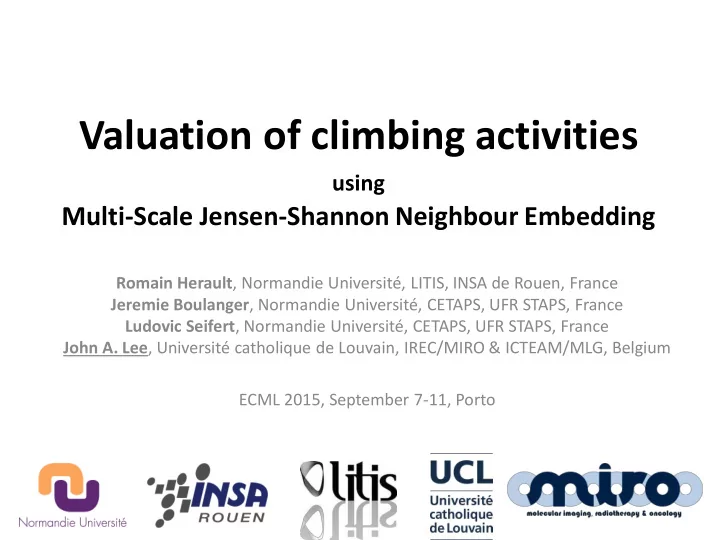

Valuation of climbing activities using Multi-Scale Jensen-Shannon Neighbour Embedding Romain Herault , Normandie Université, LITIS, INSA de Rouen, France Jeremie Boulanger , Normandie Université, CETAPS, UFR STAPS, France Ludovic Seifert , Normandie Université, CETAPS, UFR STAPS, France John A. Lee , Université catholique de Louvain, IREC/MIRO & ICTEAM/MLG, Belgium ECML 2015, September 7-11, Porto
What is the role of technique variations in learning design for practising? Can technique variations, induced by different practising environments, improve the performance in yet other environments (transfer learning)? How can we help the performer transfer this techniques to other environments?
Context of this study – Past coordination studies focus on articulations seen as oscillators, most of them are limited to two limbs Objectives – Propose a ML framework to study the full body coordination – Relate the results to climbing fluency (performance measure)
Predominant coordination patterns Two global patterns of climbing can be distinguished : – Face-wall (Beginers and experts) – Side-wall (Experts)
Experimentation • 14 climbers • 4 sessions • Same 3 paths, climbed in random order at each session: – Horizontal holds (Face-wall induced) – Vertical holds (Side-wall induced) – Horizontal + Vertical holds (Neutral) • And new path, Transfer route , at the last fourth session
Route Design Horizontal Vertical Both Face-wall Side-wall Neutral Common features: • Set to 5c • 10.3m high • 20 hand-holds
Route Design Horizontal Vertical Both Face-wall Side-wall Neutral
Recorded signals during climbers’ activities Inertial measurement unit – MotionPod3, Movea, Grenoble, France – For each of the 4 limbs and hip: • Accelerometer (Acc) • Angular speed (Gyr) • Magnetometer (Mag) – Sensor positions:
Recorded signals during climbers’ activities Transformed into 3D orientation with complementary filters
Recorded signals during climbers’ activities Videos for human annotation and possible future tracking
Measure of climbing smoothness: Jerk Trajectory duration Pelvis position Trajectory length Variation of acceleration The jerk • is an indicator of climbing fluency • has good correlation with climbing fluency/efficiency, but can not be linked to inter-limb coordination Seifert, L., Orth, D., Boulanger, J., Dovgalecs, V., Hérault, R., Davids, K. Climbing skill and complexity of climbing wall design: assessment of jerk as a novel indicator of performance fluency. Journal of applied biomechanics 30(5), 619 – 625 (2014) • does fulfill not the need of an interpretable indicator (in terms of inter-limb coordination to help the performer)
Proposed alternative processing • Looking for inter-limb coordination patterns • Signal segmentation into 4 high-level behavioral states Jérémie Boulanger, Ludovic Seifert, Romain Hérault, Jean-Francois Coeurjolly. Automatic sensor-based detection and classification of climbing activities , arXiv:1508.04153, in revision for IEEE Sensors Journal • Extraction of 3D orientation statistics (geodesic mean and variance) for each state + state distribution + state transition probabilities • Dimension reduction and clustering • Comparison to jerk
Signal segmentation Limb/hip level • Using accelero and gyro signal with a CUSUM method, limb signals are segmented into 4 activities: – Immobility When a limb is detected as being immobile – Exploration All movements except the last one before traction. An example is the case when the climber is trying several holds before choosing the one he will be using for traction – Change The last movement before traction, or the final change in hold (or change in limb orientation on the same hold) before being used – Use When a limb is moving during traction
Signal segmentation Full body level Using all the 4 limb + hip segmentations, a full body state is computed: – Immobility All limbs are immobile and the pelvis is immobile – Postural Regulation All limbs are immobile and the pelvis is moving – Hold interaction At least one limb is moving and the pelvis is immobile – Traction At least one limb is moving and the pelvis is moving
Signal segmentation Example Segmentation on each limb + full-body state
Features extracted from signals For each climb: – 20 rotation means (4 states, 5 sensors, each in R 3x3 ) – 20 rotation variances (20 reals) – State distribution (4 reals) – State transition matrix (16 reals) 220 continuous features by climb, with latent manifolds Weighted mixture of geodesic distances Dimensionality reduction (DR)
Dimensionality reduction (a.k.a. (NL)DR, manifold learning, embedding, projection, …) • Aims at representing high-dimensional (HD) data HD Near Far LD in low-dimensional (LD) spaces, while preserving structure Near • Can be Far – Linear/nonlinear – Parametric/non-parametric – Supervised/semi-supervised/unsupervised 3D → 2D
Stochastic neighbour embedding 1. Choose size K of neighbourhoods in HD space K NeRV Ms. JSE x j ξ j mixtures of ξ i x i 5. Minimise KL divergences (for all i ) 2. Convert hard neighbourhoods into soft ones 4. Define soft neighbourhoods in LD space (with unit bandwidths) 3. Adjust all bandwidths (same entropies for all i )
Results DR with Ms.JSE Projection with climber labelling
Results DR with Ms.JSE Same projection with path labelling Observations • For a particular climber, multiple clusters appears • Clusters are not necessarily linked to a path effect ( Henry example) • Are climbers’ clusters linked to a time effect (learning effect) ?
Results Hierarchical clustering (BIC: 6 clusters)
Results Temporal representation of clusters Colours: clusters; white curves: jerk (the lower the jerk, the better the fluency)
Conclusions – The clusters are correlated to fluency – Compared to the jerk, a cluster can be linked to 3D orientations (one orientation per high-level state) Improved interpretability Perspectives – An example per climb an example per signal segment – Looking at patterns on 3 first paths that lead to better performance on the 4th path (transfer learning)
Recommend
More recommend